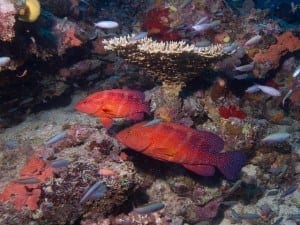
The skin cancer was found in wild coral trout and resembles melanoma in humans
Skin cancer, similar to melanoma found in humans, has been found in a wild marine fish population for the first time, according to a study conducted by Newcastle University and the Australian Institute of Marine Science.
The skin cancer was found in coral trout on the Great Barrier Reef, directly under the largest hole in the ozone layer in the world.
According to Dr. Michael Sweet of Newcastle University and leader of the research team, this is the first time cancer has been found in any wild fish and the skin cancer found is nearly identical to melanoma found in humans.
“The individuals we looked at had extensive surface melanomas, which means the cancer had not spread any deeper than the skin so apart from the surface lesions the fish were basically healthy,” Dr. Sweet said.
“Further work needs to be carried out to establish the exact cause of the cancer but having eliminated other likely factors such as microbial pathogens and marine pollution,” Dr. Sweet continued. “UV radiation appears to be the likely cause.
“Once the cancer spreads further you would expect the fish to become quite sick, becoming less active and possibly feeding less, hence less likely to be caught. This suggests the actual percentage affected by the cancer is less likely to be higher than observed in this study.”
The study found 15 percent of the 136 coral trout sampled showed dark lesions on the skin. The legions ranged from covering as little as 5 percent of the skin to almost the entire fish.
“Now it’s been found it’s more than likely that people will start to notice it elsewhere and we think we have only found the early stages,” Dr. Sweet said. “The fish with the later stages might well suffer from big behavior changes, for example they could be eaten by predators or simply die. The findings are strongly linked to UV and it’s too much of a coincidence for it not to be linked to the hole in the ozone layer.”
Until this discovery, UV-induced melanoma in fish had only been observed under laboratory conditions.












